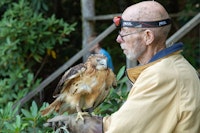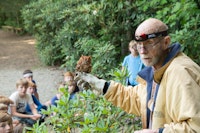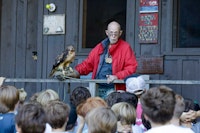Longenecker Traditions

Steve Longenecker is an outdoor educator and has been a part of the Falling Creek traditions since 1975. To many, he is known as SFL or even Father Nature.
He is beloved by all and leaves a reining legacy of Longenecker Lumps, being the creator of WEMA, Father of Rock Climbing Programs for summer camps as well as the developer of the Falconers of Falling Creek Camp’ program.
Let’s take a deeper dive into what traditions Longnecker has kept going at Falling Creek.

Learning about Wild Animals
Longenecker visits camp each session, having the opportunity to show off some birds and snakes while educating the boys on how they live in the wild.
This year, he brought a red tailed hawk, eastern screech owl, two copperheads, a rattlesnake and a ball python. He keenly educated the boys on each animal and at the end of the presentation, the boys were allowed to touch and hold the ball python.

Red Tail Hawk: a skilled hunter, using its keen eyesight to spot prey from high above. It typically hunts during the day, soaring or perching in a tree before swooping down swiftly to snatch small mammals, birds, or reptiles

Eastern Screech Owl: a nocturnal predator, relying on its excellent night vision and acute hearing to locate prey in the dark. It hunts from a perch, silently swooping down to catch insects, small rodents, or other small animals, which it then swallows whole.

Copperhead: an ambush predator, often lying motionless and camouflaged among leaves or rocks. It relies on its heat-sensing pits to detect warm-blooded prey, striking quickly when a small mammal or bird comes within range. Its venom immobilizes the prey, which the snake then consumes.

Rattlesnake: patient hunters, often using a sit-and-wait strategy. They rely on their heat-sensing pits to detect the body heat of prey, striking when a suitable animal, like a rodent, comes close. Their venomous bite immobilizes before they swallow it whole.

Ball Python: constrictors, meaning they capture prey by striking quickly and then wrapping their body around the animal, squeezing tightly until it suffocates. They typically hunt small mammals and birds at night, using their heat-sensitive pits to detect prey even in the dark.
When speaking to Steve Longenecker, you can tell he has a world of knowledge that follows him, knowledge that he happily shares with the world. When asked why he does what he does, he replied “I enjoy seeing people teach others what I have taught them. I give these boys information that they can go and take home with them. They can become educators, sharing the knowledge with their family and friends. They can take what I give them, and give it away.”




Longenecker Lumps
Although Steve Longenecker has retired from making the lumps himself, the tradition is carried on with the older boys teaching the younger boys how to make them.
I am sure you are wondering how Longenecker Lumps came to be?
Steve shared that his “lump recipe” was born during a backpacking trip in the 60s. He was working at Camp Mondamin, one of our neighbors down on Lake Summit, as backpacking counselor. “I was on a hiking trip with some boys. We had some leftover bacon grease in a small metal can and some left-over biscuit mix. I heated up the grease, dropped in a glob of dough and ‘Longenecker Lumps’ were born!”

The Recipe:
Would you like to make Longenecker Lumps at home?
- Small box of “Bisquick” pancake mix.
- Liter of cooking oil
- Sugar
- Cinnamon
Put Bisquick mix in a mixing bowl, and add water to the dry mix and mix it around until you have a big lump of dough in your bowl that is not too dry or too wet. Pinch the dough into the perfect-sized “Lump” by rolling each one around between your palms until it is formed just right. When the oil is hot enough, gently add the raw “lumps” to the cooking oil and let them cook until it’s time to roll them in the sugar/cinnamon mixture.
Taste the Tradition
Campers both young and old can probably close their eyes and smell this video! Cooking (and eating!) Longenecker Lumps at camp.
More Camp Recipes